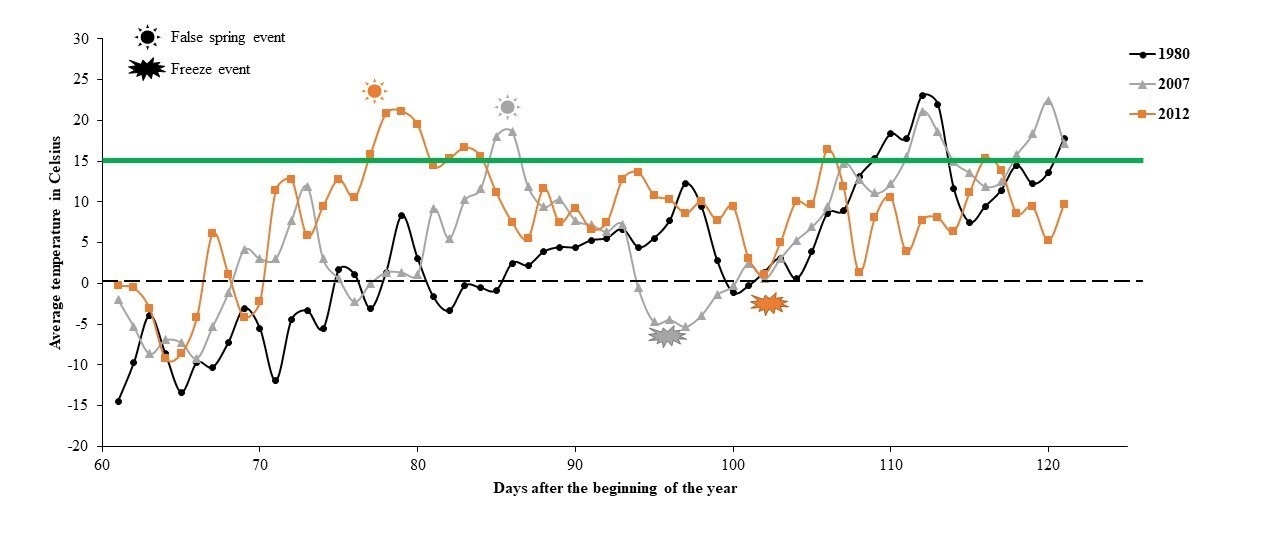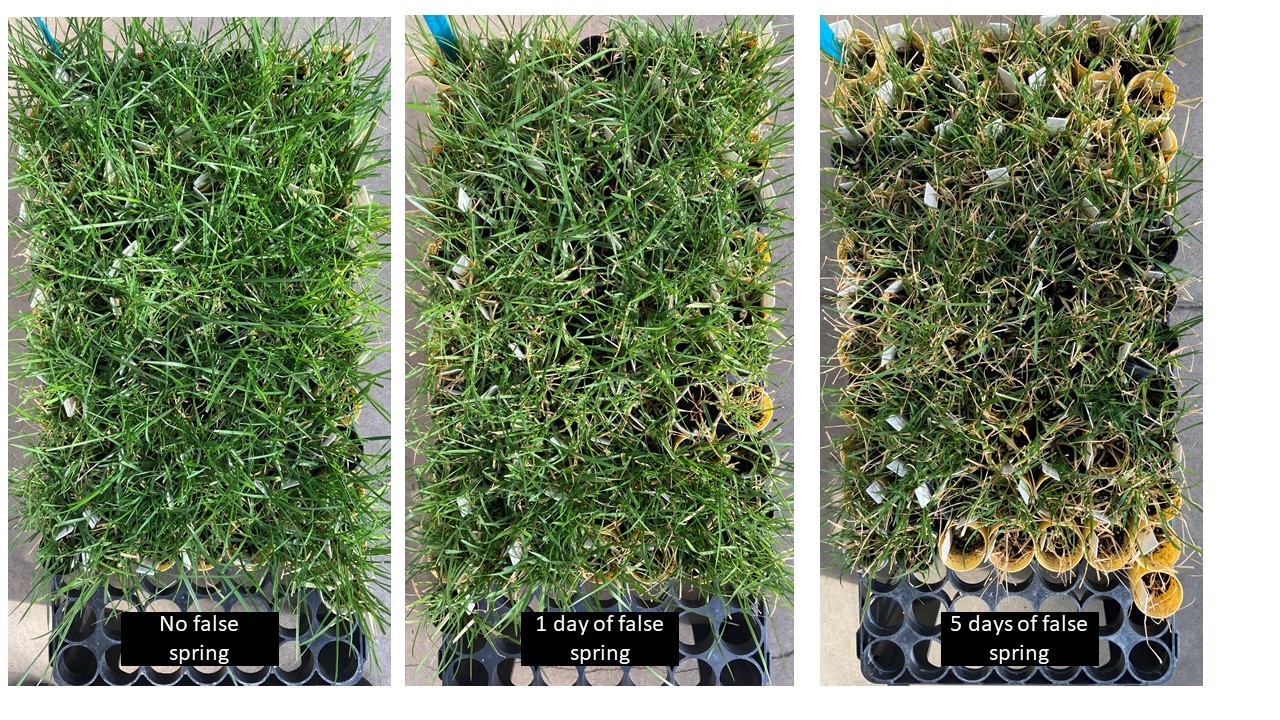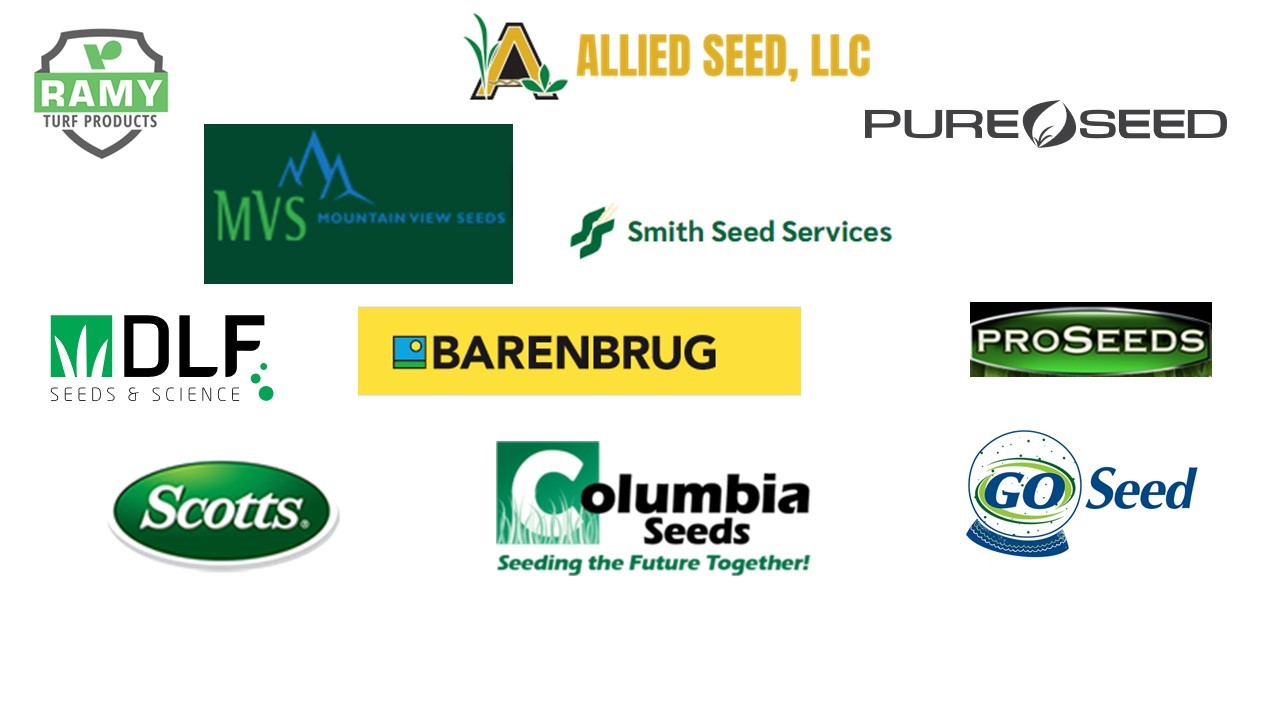By Florence Sessoms
In the late 20th century, we have been constantly warned about global warming--ice caps melting, polar bear habitat disappearing, land being lost to rising seas. But is warming the only danger? Today we prefer to use the term climate change; it is more accurate than global warming because not only are seasons getting warmer, but detrimental weather fluctuations are also occurring during interseason periods. This is the case with false springs that can be described by a stretch of unexpectedly warmer temperatures in late winter/early spring followed by sudden freezing events. These warm-freeze fluctuations can be environmentally and economically problematic: plants will use the longer days, higher light intensity, and warmer temperatures as environmental cues to break from their winter dormancy. As the plant develops during these warm periods, it becomes more and more sensitive to a sudden freeze resulting in potential failure. In the United States, three recent false spring events led to high monetary losses; for example in March 2007 the eastern US recorded above average temperatures that suddenly ended in early April (known as the “2007 Easter Freeze”); this false spring event caused around $2 billion of crop losses (Gu et al,2008). In 2012, another false spring (warmer temperature in March followed by April freezing temperatures) event located in the northeastern US and the Great Lakes region also provoked significant yield losses (Ault et al, 2013). More recently, in 2017 the eastern US had warmer temperatures in February followed by a freeze event in March. The 2007 and 2012 false spring events can be visualized for central Minnesota by looking at the temperature records from the University of Minnesota station (Figure 1).
False spring events have also been observed in Europe; in 2021, almost all vineyards in France and fruit crop yield were affected by a false spring event. Here are powerful pictures of winemakers attempting to keep the frost at bay with small fires between the rows of vines.
Can false spring also affect turfgrass species?
False spring events can affect any agricultural crop (cereals, legumes, fruit trees) and perennial grasses such as turfgrass. According to Kral-O’brien et al. (2019), false spring damage on perennial grasses can lead to:
- Reduced growth rate of perennial vegetation that survived the freezing event. This could lead to an increase of weed incidence; for example, crabgrass seeds that germinate later in the spring could take advantage of the decreased turfgrass density. Furthermore, the presence of bare soil or absence of an active rooting system could lead to soil erosion and nutrient leaching.
- Reduced flower production and subsequent seed yield losses. This could be problematic for turfgrass seed producers or homeowners that have established bee lawns.
- Reduced tolerance to further abiotic and biotic stresses. Turfgrasses could suffer during summer stress periods.
How to prevent the effect of false spring on turfgrass?
We were recently awarded a grant from the Ontario Turfgrass Research Foundation to study the effect of de-hardening or winter de-acclimation on the freeze tolerance of newly produced tall fescue cultivars. We focused on tall fescue because this species of turfgrass presents a very good tolerance to wear, heat and drought. It can survive our Minnesotan winter except in the presence of snow mold or in the event of ice encapsulation. More information about tall fescue can be found on this previous blog article: When seed is short, the solution is tall (fescue).
Our false spring experiments were performed in controlled (growth chamber) and in field conditions.
Growth chamber experiment. Researchers in plant science like to use growth chambers because they allow for the manipulation of different environmental parameters (day length, light intensity, light quality, temperature, humidity), easy access to our plants and better monitoring of plant’s needs (fertilizer, irrigation, pest control). In our experimental protocol, 79 tall fescue cultivars were grown under fall-like conditions: over a period of 73 days the day length decreased from 13 hours to 9 hours, and the average day/night temperature decreased from 23/12 °C to 0/-5 ºC. For the following 8 days, the plants were grown under 8 hour days at a temperature of -5°C; during this time the light intensity was decreased from 300 μmol m–2s–1 during fall to 50 μmol m–2s–1 to mimic the presence of a snow cover. Next, the false spring event was created by increasing the day length to 12 hours, light intensity to 300 μmol m–2s–1 and day/night temperature to 15/13 ºC, which was then followed by a controlled freezing event at -14 °C. Three treatments were performed for each tall fescue cultivar: 1) control (no false spring), 2) 1 day of false spring and 3) 5 days of false spring. Our initial observation (first experimental run) showed that all cultivars were resistant to the -14 °C freeze if they were not subjected to a false spring event (Figure 2). One day of false spring resulted in the same observation but some damage was starting to occur (frost kill and lower green-up) after 5 days of false spring event (Figure 2). More experimental runs are being done to confirm these observations.
We believe that tall fescue could be an ideal species for false spring tolerance thanks to its delayed spring greenup. False springs are recorded in early April, and plant species that break dormancy faster seem to be more susceptible to these freezing events. However, other winter injuries (snow mold and ice damage) are still problematic for this species. Proper management practices (late summer seeding time and fungicide application) and lawn preparation (appropriate water drainage to avoid ice accumulation) could alleviate these winter stresses on this species. We will discuss the accompanying experiment conducted in the field in Part 2 of this blog.
I would like to thank the seed companies that generously provided the tall fescue cultivars.
References
Ault, T.R., G.M. Henebry, K.M. de Beurs, M.D. Schwartz, J.L. Betancourt, and D. Moore. 2013. The false spring of 2012, earliest in North American record. Eos, 94 (20): 181-188.
Gu, L., P.J. Hanson, W.M. Post, D.P. Kaiser, B. Yang, R. Nemani, S.G. Pallardy, and T. Meyers. 2008. The 2007 Eastern US spring freeze: increased cold damage in a warming world? BioScience, 58 (3): 253-261.
Kral-O’Brien, K.C. P.L., O’Brien, and J.P Harmon. 2019. Need for false spring research in the Northern Great Plains, USA. Agricultural & Environmental Letters, 4:190025. doi:10.2134/ael2019.07.0025


